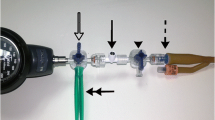Abstract
Background
Air enema under fluoroscopy is a well-accepted procedure for the treatment of childhood intussusception. However, the reported radiation doses of pneumatic reduction with conventional fluoroscopy units have been high in decades past.
Objective
To compare current radiation doses at our institution to past doses reported by others for fluoroscopic-guided pneumatic reduction of ileo-colic intussusception in children.
Materials and Methods
Since 2007 radiologists and residents in our department who perform reduction of intussusceptions have received a radiation risk training. We retrospectively analyzed the data of 45 children (5 months–8 years) who underwent a total of 48 pneumatic reductions of ileo-colic intussusception between 2008 and 2012. We analyzed data for screening time and dose area product (DAP) and compared these data to those reported up to and including the year 2000.
Results
Our mean screening time measured by the DAP-meter was 53.8 s (range 1–320 s, median 33.0 s). The mean DAP was 11.4 cGy∙cm2 (range 1–145 cGy∙cm2, median 5.45 cGy∙cm2). There was one bowel perforation, in a 1-year-old boy requiring surgical revision. Only three studies in the literature presented radiation exposure results on children who received pneumatic or hydrostatic reduction of intussusception under fluoroscopy. Screening times and dose area products in those studies, which were published in the 1990s and in the year 2000, were substantially higher than those in our sample.
Conclusion
Low-frequency pulsed fluoroscopy and other dose-saving keys as well as the radiation risk training might have helped to improve the quality of the procedure in terms of radiation exposure.
Similar content being viewed by others
References
Daneman A, Alton DJ (1996) Intussusception. Issues and controversies related to diagnosis and reduction. Radiol Clin North Am 34:743–756
Applegate KE (2009) Intussusception in children: evidence-based diagnosis and treatment. Pediatr Radiol 39:S140–S143
Heenan SD, Kyriou J, Fitzgerald M et al (2000) Effective dose at pneumatic reduction of paediatric intussusception. Clin Radiol 55:811–816
Ilivitzki A, Shtark Glozman L, Arish K et al (2012) Deep sedation during pneumatic reduction of intussusception. Pediatr Radiol 42:562–565
Karlsson A, Schuwert P, Mortensson W (1994) Radiation exposure to children in diagnosing and at hydrostatic reduction of intussusception. Acta Radiol 35:296–299
Thomas RD, Fairhurst JJ, Roberts PJ (1993) Effective dose during screening monitored intussusception reduction. Clin Radiol 48:189–191
Meyer JS, Dangman BC, Buonomo C et al (1993) Air and liquid contrast agents in the management of intussusception: a controlled, randomized trial. Radiology 188:507–511
Guo JZ, Ma XY, Zhou QH (1986) Results of air pressure enema reduction of intussusception: 6,396 cases in 13 years. J Pediatr Surg 21:1201–1203
Eshel G, Barr J, Heyman E et al (1997) Intussusception: a 9-year survey (1986–1995). J Pediatr Gastroenterol Nutr 24:253–256
Daneman A, Alton DJ, Ein S et al (1995) Perforation during attempted intussusception reduction in children — a comparison of perforation with barium and air. Pediatr Radiol 25:81–88
Persliden J, Schuwert P, Mortensson W (1996) Comparison of absorbed radiation doses in barium and air enema reduction of intussusception: a phantom study. Pediatr Radiol 26:329–332
Wang GD, Liu SJ (1988) Enema reduction of intussusception by hydrostatic pressure under ultrasound guidance: a report of 377 cases. J Pediatr Surg 23:814–818
Daneman A, Navarro O (2004) Intussusception. Part 2: an update on the evolution of management. Pediatr Radiol 34:97–108
Conflicts of interest
None
Author information
Authors and Affiliations
Corresponding author
Rights and permissions
About this article
Cite this article
Cullmann, J.L., Heverhagen, J.T. & Puig, S. Radiation dose in pneumatic reduction of ileo-colic intussusceptions — results from a single-institution study. Pediatr Radiol 45, 675–677 (2015). https://doi.org/10.1007/s00247-014-3218-3
Received:
Revised:
Accepted:
Published:
Issue Date:
DOI: https://doi.org/10.1007/s00247-014-3218-3




